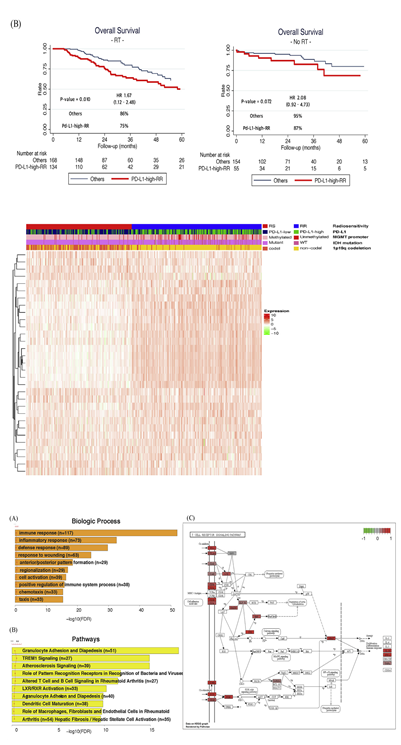글로벌 연구동향
방사선종양학
- 2018년 09월호
[Radiother Oncol.] A radiosensitivity gene signature and PD-L1 predict the clinical outcomes of patients with lower grade glioma in TCGA.서울의대 / 장범섭, 김인아*
- 출처
- Radiother Oncol.
- 등재일
- 2018 Aug
- 저널이슈번호
- 128(2):245-253. doi: 10.1016/j.radonc.2018.05.003. Epub 2018 May 18.
- 내용

Abstract
PURPOSE:
Identifying predictive factors for the clinical outcome of patients with lower grade gliomas following radiotherapy could help optimize patient treatments. Here, we investigate the predictive efficacy of both a previously identified "31-gene signature" and programmed death ligand-1 (PD-L1) expression.MATERIAL AND METHODS:
We identified 511 patients with lower grade glioma (Grade 2 and 3) in The Cancer Genome Atlas dataset and divided them into two clusters: radiosensitive (RS) and radioresistant (RR). Patients were also classified as PD-L1-high or PD-L1-low based on CD274 mRNA expression. Five-year survival rates were compared across patient groups, and differentially expressed genes were identified via a gene enrichment analysis.RESULTS:
Among 511 patients with lower grade glioma in The Cancer Genome Atlas dataset, we identified a group that was characterized by radioresistant and high PD-L1 (the PD-L1-high-RR group). Multivariate Cox models demonstrated that the membership in the PD-L1-high-RR can predict overall survival regarding to RT. Differentially expressed genes associated with the PD-L1-high-RR group were found to play a role in the immune response, including the T-cell receptor signaling pathway.CONCLUSION:
We tested the predictive value of a "31-gene signature" and PD-L1 expression status in a dataset of patients with lower grade glioma. Our results suggest that the patient population classified as the PD-L1-high-RR may benefit most from radiotherapy combined with anti-PD-1/PD-L1 treatment. Prospective clinical trial is necessary to validate the findings in a homogenous treated patient cohort.
Author informationJang BS1, Kim IA2.
1
Department of Radiation Oncology, Seoul National University Hospital, Republic of Korea.
2
Department of Radiation Oncology and Cancer Research Institute, Seoul National University, College of Medicine, Republic of Korea; Department of Radiation Oncology, Seoul National University Bundang Hospital, Seongnamsi, Republic of Korea. Electronic address: inah228@snu.ac.kr.
- 키워드
- Glioma; PD-L1; Radiation; Radiosensitivity; TCGA
- 연구소개
- lower grade gliome 환자군에서 immune check point blockade anti-PD-1/PD-L1 inhibitor와 radiation therapy와의 병합치료에 좋은 반응을 보일 수 있는 환자군을 The cancer genome atlas의 transcriptome data에서 알아보고자 한 연구이다. Radiosensitivity gene signature 상 방사선저항성을 보이면서도 PD-L1을 높게 발현하는 환자(PD-L1-high-RR)에게 있어서 방사선 치료를 받았을 경우에만 다른 그룹에 비해 저조한 생존률 보였으며, radiosensitivity와 PD-L1 status가 방사선치료 후 예후에 대한 예측력을 가짐을 규명하였다. 또한 PD-L1-high-RR에 속하는 그룹이 T-cell receptor signaling을 포함한 immune response와 관련된 경로의 변화를 동반하고 있어 anti-PD-1/PD-L1 inhibitor와 radiation therapy와의 병합치료에 좋은 반응을 보일 수 있는 그룹임을 보고하였다.
- 덧글달기
- 이전글 [Radiother Oncol.] Survival gain with re-Op/RT for recurred high-grade gliomas depends upon risk groups.
- 다음글 [Cancer Res Treat.] The Prognostic Impact of the Number of Metastatic Lymph Nodes and a New Prognostic Scoring System for Recurrence in Early-Stage Cervical Cancer with High Risk Factors: A Multicenter Cohort Study (KROG 15-04).







